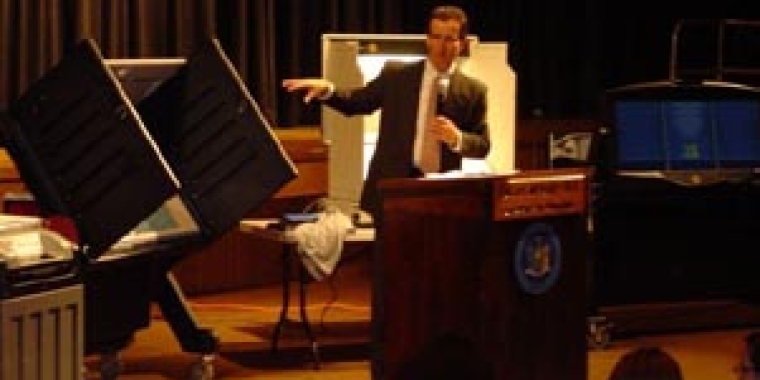
Senator Flanagan Unveils Modern Computerized Voting Systems

Senator John Flanagan (R,C-East Northport), Chairman of the Senate Elections Committee, today unveiled several new voting technologies to a group of government students at Ward Melville High School. The new machines are the result of recently enacted state legislation that was necessary to comply with federal voting standards established after the 2000 Presidential election and the controversial vote count.
"I am pleased to introduce the next generation of voting machines to our state’s next generation of voters," Senator Flanagan said. "The central aim of the federal Help America Vote Act (HAVA) was to improve the accessibility, reliability and verifiability of our voting system. New York State has achieved that goal and more with the adoption of these new federal voting standards. The majority of the students here today will vote for the first time in the 2006 elections using machines similar to those here. It is critically important that we begin the process of educating them, and all voters, on the changes made to the electoral process to instill public confidence that all votes will be properly counted at the end of every election."
Under the federal legislation, minimum voting standards were established for all states to adopt and a total of $3.9 billion in federal funding was appropriated to assist states with implementing these new guidelines. New York State has already received $220 million of this funding, of which $190 million is earmarked to replace outdated voting equipment.
"The changes made by HAVA represent the most significant election reforms that have taken place in our country since World War II," said Senator Flanagan. "These improvements are essential to modernizing our elections process and ensuring the integrity of our voting system."
The recently enacted HAVA legislation addresses voter verification issues, voting complaint procedures and centralization of voter registration lists. But the linchpin of HAVA is the replacement of New York’s out-of-date lever machines with modern computerized voting technologies such as optical scan systems or direct recording electronic (DRE) technologies.
Direct Recording Electronic (DRE) Voting Systems
Somewhat similar to ATM machine technology, the DRE system provides voters the use of electronic devices to enter their ballot choices. Some DRE machines offer touch screen capabilities while others offer a push button feature.
To provide a tangible record, DRE machines in New York State are required by law to create a voter verifiable paper audit trail of each ballot cast that can be viewed by the voter at the time the ballot is cast.
DRE machines are handicapped accessible including features such as Braille, headphones for blind and language impaired individuals and other features designed to allow disabled voters to cast a ballot unassisted.
Optical Scan Systems
Similar to standardized test answer sheets, voters with an optical scan system utilize a pen or pencil to fill out paper ballots. The paper ballot is then fed into a machine that reads the voters’ marks electronically and tallies the votes. The machine retains the paper ballot which can later be used for recounts.
The optical scan system is not handicapped accessible and as such requires each polling location to utilize an optical scan system to offer a ballot marking device. The ballot marking devices do not record or count votes electronically, they only assist voters in marking a paper ballot. Ballot marking devices provide voters with ballot secrecy by replacing a human assistant, with an automated assistant.
Flanagan said the state Board of Elections is currently finalizing the draft regulations on the machine criteria before they begin their public comment process. Once the final regulations are approved the vendors will begin submitting their machines for testing and certification by the Board. In addition, a Citizen Election Modernization Advisory Committee is in the process of being formed which will review the existing technologies and will advise the Board as to what machines meet both federal and state voting machine standards. Once the SBOE certifies that a machine meets the standards it will be eligible to be purchased by a county. To ensure bulk purchase savings, the SBOE will act as the purchasing agent and direct the State Comptroller to release HAVA funds to vendors who in turn deliver the machines to the counties.
In addition to showing the students the modern computerized voting systems, Senator Flanagan discussed the following aspects of the Help America Vote Act with the Ward Melville students:
Statewide Voter Registration List
HAVA requires each state to create a centralized voter registration list. New York will allocate more than $20 million to develop this comprehensive database, which will serve as the official record of registration for each voter. Local election boards will transmit voter registration records electronically to the State Board of Elections for integration into a single list.
"For the first-time in this state’s history, a statewide voter registration list will be created, making our registration process more efficient, manageable and secure," said Flanagan. "When established, this centralized system will insure that each voter is registered only once, while also providing the state with a mechanism to detect possible errors and/or voter fraud."
Senator Flanagan went on to say, "The system we have structured, along with new voter verification and voter identification processes is the linchpin of what Congress envisioned to prevent voter fraud and ensure that each voter has only one vote."
Noting the importance of establishing a centralized voter registry, Senator Flanagan cited a recent report which reviewed voter file information across State lines and found that nearly 700,000 people were registered in more than one State and over 3,000 double-voted in the 2000 election.
Administrative Complaint Procedure
The State’s enabling legislation also provides an administrative complaint procedure for individuals who believe that a violation of voting procedure or election law has occurred. The procedure allows for complaints to be filed in person, in writing, or by telephoning the state or local elections board, and requires a final determination be rendered by the State Board of Elections within 90 days of the issued complaint.
"The administrative complaint process is one of the most significant aspects of HAVA, because it provides immediate access for anyone who believes a violation has occurred and requires that complaints be addressed in a timely fashion," said Senator Flanagan. "We need to assure the public that their voices will be heard when they believe something is wrong with our election process to maintain fairness and reliability in a system that was established on our basic principles of democracy."
County Consolidation of Elections
In order to improve the administration of elections under the new demands of HAVA, the Conference Committee concluded that all election functions should be consolidated at the county level. Counties will have the exclusive responsibility over all election functions, including purchasing/owning voting machines, conducting elections and training poll workers. In areas of the State where these functions were previously the responsibility of towns and cities, a county (by vote of the county legislature) will be able to recoup election costs from these local entities to avoid shifting any added expenses to that county’s budget.
"To effectively and efficiently implement all aspects of this legislation, the state required a common denominator," said Senator Flanagan. "Statewide, more than 20,000 voting machines must be replaced for use at over 7,500 poll sites, and nearly 78,000 poll workers must be properly trained. Designating county election boards to coordinate all these activities was a logical step to establish uniformity and consistency throughout this vast, diverse state."
Voter Verification/Voter ID
The provisions of HAVA also require states to properly verify a person’s identity when they register to vote. Individuals must provide a driver’s license or the last four digits of their social security number, which will be verified by the State Board of Elections in coordination with the Department of Motor Vehicles and the Social Security Administration. In the event these proofs of identity are unavailable, a unique number will be assigned to an individual by a board of elections before their application can be processed and accepted.
Once an application is filed with the State Board of Elections, it may be accepted, rejected or require more information. Where more information is required, individuals will be notified of their status and marked in the poll book as requiring more information. However, procedures will be in place to verify an individual’s identity at the polls.
All voters will be allowed to vote using provisional (affidavit) ballots if they forget ID or are not listed in poll books. Once election officials successfully verify an individual’s identity and/or voter registration, his or her ballot would be counted. Provisional voting helps to ensure that no eligible voter is turned away at the polls.
Senator Flanagan said, "The legislation we enacted provides every reasonable opportunity for individuals to legally register and exercise their right to vote. However, important checks and balances were also put in place to protect eligible voters from being victims of voter fraud and error."



